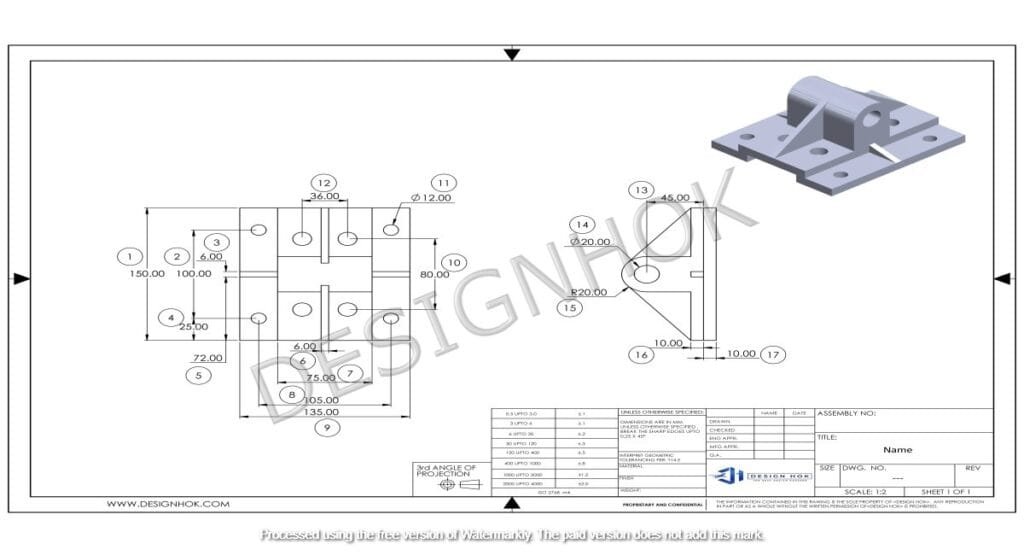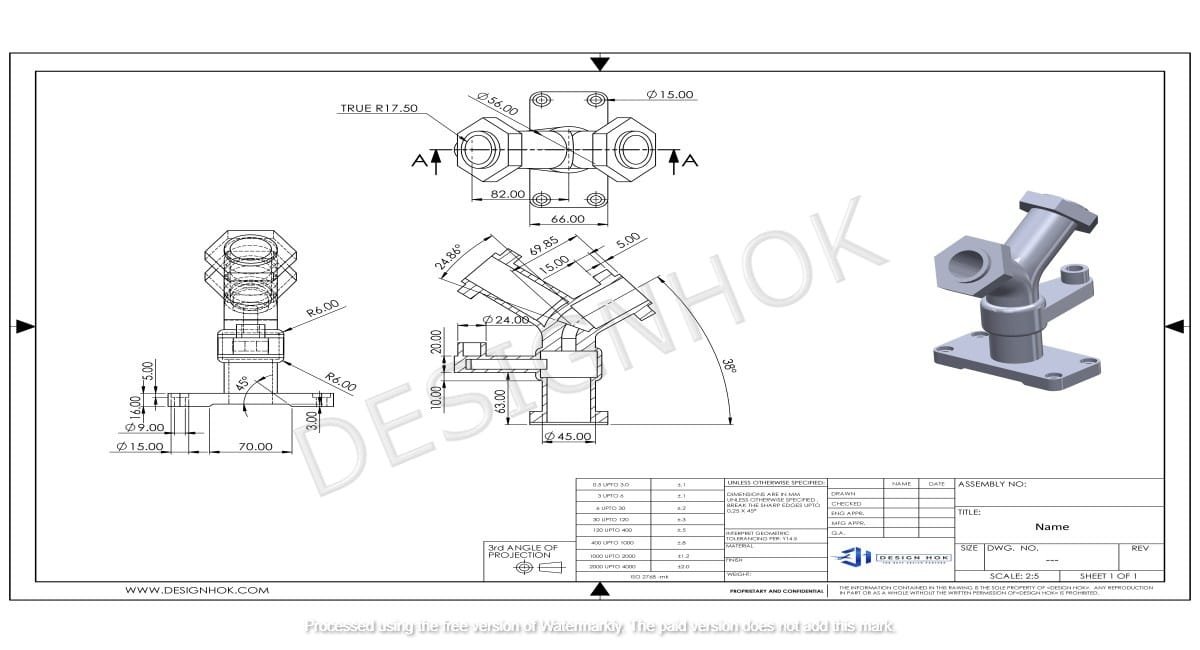Description:
2D drawings in CAD play a crucial role in the design and engineering process, providing detailed layouts, precise dimensions, and a clear foundation for manufacturing. The article discusses the purpose and importance of 2D CAD drawings in various industries, showing why they remain essential tools in modern design.
What Is the Purpose of the 2D Drawings in CAD Design?
Computer-Aided Design (CAD) has transformed the engineering and design fields, making it easier to create detailed plans for everything from tiny machine parts to massive architectural structures. Within CAD, 2D drawings are fundamental for visualizing, planning, and sharing ideas. But what exactly is the purpose of 2D drawings in CAD, and why do they remain important when 3D modeling has become popular?
the reasons why 2D Drawings in CAD Design, the benefits they bring, and the role they play in successful design and manufacturing processes.
1. Foundation for Design and Planning
2D Drawings in CAD Design act as the foundation for many design projects. Before complex 3D models can be built, 2D layouts help define the overall structure and outline of a design. These flat representations give designers a clear understanding of the project’s basic dimensions, shapes, and spatial layout.
2D drawings allow for initial ideas to be mapped out quickly, giving both designers and clients a straightforward view of the design’s purpose and requirements. This stage is essential for the planning process, as it helps catch potential issues early and gives a basic overview of the structure without adding complex 3D details.

2. Simplicity and Clarity in Communication
Communication between designers, engineers, and clients is critical, and 2D drawings in CAD Design simplify this process. With clear, precise drawings, stakeholders can understand the design without needing technical knowledge of 3D software.
These 2D representations convey basic ideas and layouts effectively, helping teams avoid miscommunication and ensuring everyone involved has the same understanding of the project. By presenting a simpler view, 2D drawings make complex design concepts accessible to a broader audience.
3. Cost-Effective and Time-Saving Tool
Creating 3D models can be time-consuming and costly, especially in the early stages of design. 2D CAD drawings provide an affordable alternative, allowing for quick drafts that give a comprehensive overview without demanding extensive resources.
In industries where speed is essential, like manufacturing or construction, 2D Drawings in CAD Design offer a way to keep projects moving forward efficiently. Designers can quickly create and share 2D layouts to test ideas, adjust dimensions, or present options without investing too much time or money.
4. Precise Detailing for Manufacturing
For manufacturing processes, precise measurements and specifications are essential. 2D drawings provide the exact dimensions and tolerances that engineers and manufacturers rely on to create accurate parts and products. These measurements are especially important in fields like automotive and aerospace engineering, where even a tiny error can cause serious issues.
2D Drawings in CAD Design break down complex structures into parts that can be easily measured, cut, and assembled, making them invaluable in precision industries. Manufacturers often use these 2D layouts as blueprints for assembly, helping to ensure that every component fits as intended.

5. Compatibility with Standard Industry Practices
In many industries, 2D Drawings in CAD Design remain the standard for documentation, review, and inspection. Engineers, architects, and builders are accustomed to reading these drawings as part of their everyday tasks, and these documents often meet regulatory and safety standards more easily than other formats.
By creating 2D Drawings in CAD Design, designers ensure compatibility with established industry practices, allowing for easy transfer of information between teams. This compatibility streamlines the production process and reduces the likelihood of misunderstandings.
6. Ideal for Engineering Diagrams and Schematics
In fields such as electrical engineering or plumbing, 2D CAD drawings are ideal for schematics and diagrams. These drawings provide clear representations of wiring paths, piping layouts, and system flows, which are essential for construction and installation.
For complex systems with multiple components, 2D Drawings in CAD Design offer a way to map connections and dependencies simply. This level of clarity is vital when installing, troubleshooting, or repairing intricate systems, as it allows technicians to follow paths accurately.
7. Easier Revision and Updates
2D Drawings in CAD Design make it easy to revise and update designs without starting from scratch. When adjustments or refinements are needed, 2D drawings can be modified quickly and shared with team members.
Whether it’s adding a new feature or adjusting measurements, 2D layouts offer a flexible solution. Designers can update these drawings efficiently, allowing projects to adapt to new requirements without major delays.
8. Reducing Design Complexity
In some projects, 3D models are unnecessary, and 2D Drawings in CAD Design provide the needed information without adding complexity. When only a basic outline or measurement is required, 2D drawings simplify the process, saving time and effort.
This is especially useful in smaller projects, where full 3D modeling may not be justified. By reducing the complexity of the design process, 2D CAD drawings ensure that resources are used effectively, focusing on delivering what’s necessary for the project’s success.
9. Essential for Creating Documentation
Documentation is a key part of any design or manufacturing process, and 2D CAD drawings provide a clear and organized format for recording essential details. These drawings become part of a project’s documentation, providing a reliable reference for future adjustments, repairs, or updates.
With CAD software, these 2D drawings can be stored, retrieved, and modified over time, helping companies maintain a complete record of their designs. This documentation is often required by regulatory bodies, making 2D drawings essential for compliance.
Conclusion
2D Drawings in CAD Design are much more than simple outlines; they are an essential tool in design, planning, and production across many industries. By providing clear layouts, precise measurements, and easy-to-read documentation, 2D CAD drawings help simplify complex processes, reduce costs, and ensure quality in manufacturing. While 3D modeling adds depth and realism, 2D CAD drawings remain indispensable for their clarity, efficiency, and practicality in turning ideas into finished products.
FAQs
1. Why are 2D CAD drawings still used when 3D modeling is available?
2D drawings offer simplicity, ease of communication, and precise measurements, which are especially useful in the early stages of design and manufacturing.
2. Can 2D CAD drawings be used for complex designs?
Yes, 2D drawings are suitable for complex designs, especially for initial layouts, dimensions, and schematics that need clear, detailed plans.
3. How do 2D drawings help reduce costs?
2D CAD drawings are faster and less resource-intensive to create than 3D models, allowing teams to test and revise ideas affordably.
4. What industries benefit most from 2D CAD drawings?
Industries such as manufacturing, construction, automotive, and engineering heavily rely on 2D drawings for accurate and efficient design and production.
5. Are 2D CAD drawings enough for final product assembly?
Yes, for many products, detailed 2D CAD drawings provide the necessary information for accurate assembly, especially when precise measurements are critical.





